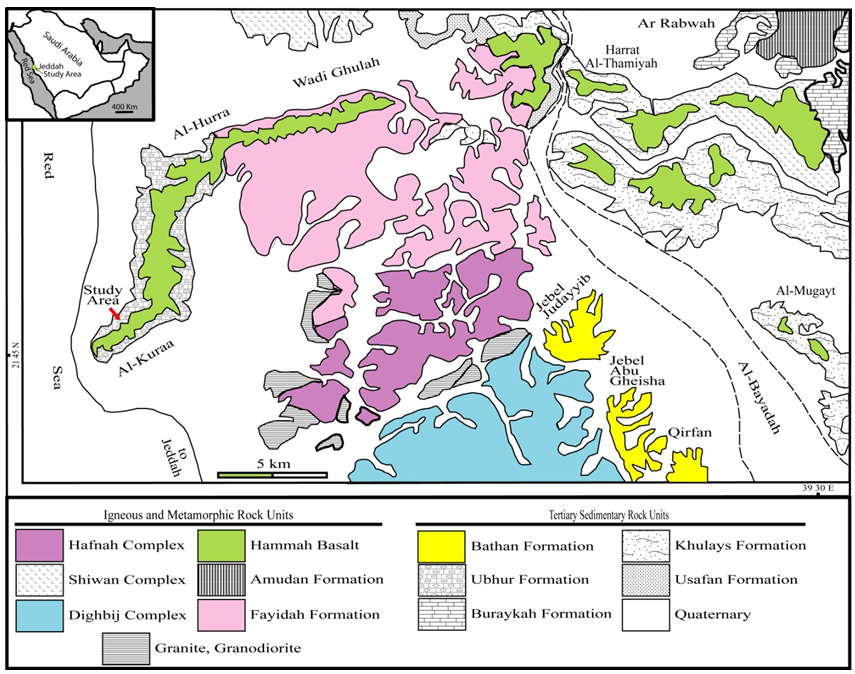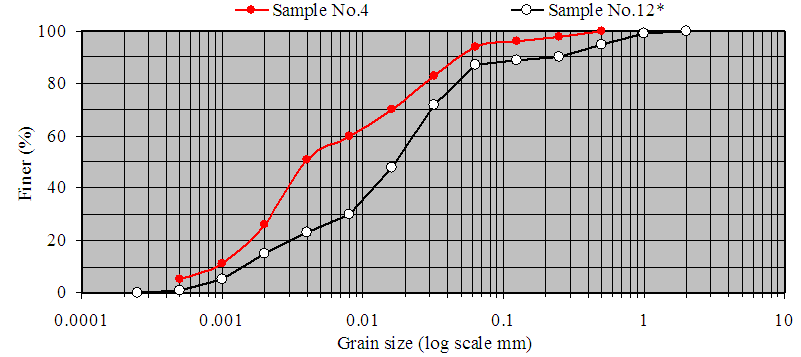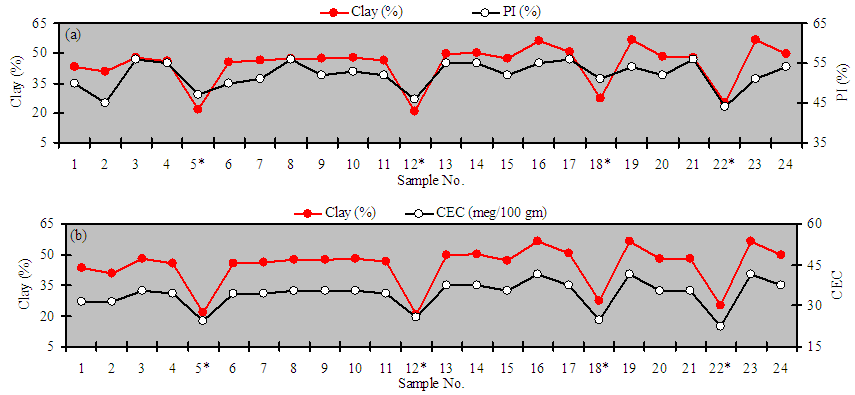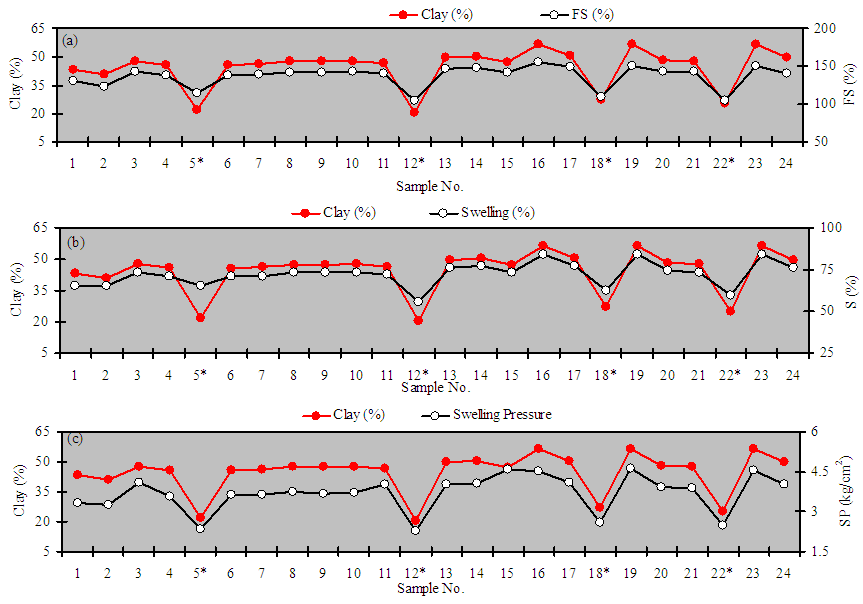-
Paper Information
- Paper Submission
-
Journal Information
- About This Journal
- Editorial Board
- Current Issue
- Archive
- Author Guidelines
- Contact Us
Journal of Civil Engineering Research
p-ISSN: 2163-2316 e-ISSN: 2163-2340
2016; 6(1): 7-15
doi:10.5923/j.jce.20160601.02

Geotechnical Evaluation of Miocene Expansive Shale, Jeddah, Saudi Arabia
Abdulelah A. Bahabri
Faculty of Earth Sciences, King Abdulaziz University, Jeddah, Saudi Arabia
Correspondence to: Abdulelah A. Bahabri, Faculty of Earth Sciences, King Abdulaziz University, Jeddah, Saudi Arabia.
| Email: |  |
Copyright © 2016 Scientific & Academic Publishing. All Rights Reserved.
This work is licensed under the Creative Commons Attribution International License (CC BY).
http://creativecommons.org/licenses/by/4.0/

Expansive shale has been found extensively in all over the world especially in arid and semi-arid regions. The ground heave resulted from shale swelling potential are considered as a multi factorial phenomenon. The Miocene Shale of Bathan Formation composes mainly of shale beds with sandy silt thinly interbedded layers which formed during several cycles of sedimentation. The swelling potentiality of expansive shale of Bathan Formation (Middle to Late Miocene) in NE Jeddah, Saudi Arabia was evaluated based on physico-chemical and mechanical measurements. Its swelling potentiality (free swelling, swelling percent and swelling pressure) has a direct relationship with clay fraction content, plasticity index (PI) and cation exchange capacity (CEC). Furthermore, the clay fraction percent has a strong direct proportional relation to free swelling, plasticity index (PI) and cation exchange capacity (CEC).
Keywords: Expansive shale, Miocene, Jeddah, Saudi Arabia
Cite this paper: Abdulelah A. Bahabri, Geotechnical Evaluation of Miocene Expansive Shale, Jeddah, Saudi Arabia, Journal of Civil Engineering Research, Vol. 6 No. 1, 2016, pp. 7-15. doi: 10.5923/j.jce.20160601.02.
Article Outline
1. Introduction
- Expansive clayey materials (shale and soil) are considered as a worldwide problem. These expansive clayey materials are occurred in all over the world especially in arid and semi-arid regions where the rate of evaporation is higher than the annual rainfall thus there is almost always a moisture deficiency in these clayey materials. Semi-arid regions (e.g. Saudi Arabia) are characterized by short periods of rainfall followed by long periods of draught causing cyclic swelling and shrinking phenomena. The ground heave that results from clayey materials swelling potential is a multifactorial phenomenon that involves a combination of the type of material, type and amount of clay minerals, microfabric, initial moisture content, and initial dry density [1]. These clayey materials cause extensive damages to the structures and infrastructure on top of them [2-9]. This problematic phenomenon is mainly owing to small particle size, large specific surface area, swelling clay minerals and high cation exchange capacity [10-12]. Consequently, the expansive shale considered as a type of problematic rock and considered as a potential natural hazard. In Saudia Arabia, the expansive soils and shales nearly cover an area of about 800,000 km2 [13]. The swelling potentiality of the expansive soils and shales in the western regions of Saudi Arabia is intensified by the arid climatic conditions and severe weathering environment [14-15]. The main goal of this study is evaluating the swelling potentiality of Miocene shale in north eastern parts of Jeddah, Saudi Arabia.
2. Geological Setting of the Study Area
- The studied Miocene shale beds are exposed as elevated area at Al-Rehaili, NE Jeddah City (Fig. 1). Topographically, the area has an elongated antiform shape, running in the NE–SW direction, having a maximum elevation of about 45 m above sea level and bounded by NE–SW trending Wadis; Wadi Al-Kura to the south and Wadi Ghula to the north [16]. In the investigation area, the basement rocks of Precambrian are un-conformably outcropping to the east and are overlain by sedimentary rocks of Tertiary age especially in the west and by lavas of Miocene to Pliocene age in the north (Moore and Al-Rehaili, 1989). Extensive areas of Quaternary surficial deposits (sand and gravel) are extended on the coastal plain and in the major wadis (Fig. 1). Bathan Formation at Al-Rehaili area, NE Jeddah City, Saudi Arabia considered as typical expansive shale encountered. This Miocene shale encountered as typical expansive shale. Its clayey rich shale beds are generally over-consolidated, separated by erosion surfaces and extremely desiccated and cracked (Fig 2). The studied expansive shale beds are belonging to Bathan Formation which firstly described by [18]. These expansive shale beds are of lacustrine origin during probably Middle to Late Miocene [19].
 | Figure 1. Geological map of the studied area, NE Jeddah, Saudi Arabia after [17] |
3. Test Procedures
- Twenty four disturbed and undisturbed samples were collected and subjected to several types of tests. The initial moisture water content was determined by heating samples to 110ºC for 24hrs according to [20]. Specific gravity was determined according to [21]. Similarly, the liquid limit (LL) and plastic limit (PL) were performed according to [22]. Grain-size distribution was done using sieve analysis and hydrometer test for sand-silt and clay-sized fractions respectively. The laboratory tests were designed to investigate the swelling behavior (swelling pressure and swelling percentage) using odeometer testing according to [23]. Free swell test was carried out as described by [24]. The chemical analyses were performed to determine the exchangeable cations (Na+, K+, Ca++ and Mg++). The cations were extracted with ammonium acetate (pH 7), with subsequent determination of the cations by standard methods as described by [25]. The exchangeable sodium and potassium cations were measured by the flame photometry method and the calcium and magnesium cations by atomic absorption spectrophotometry. Cation exchange capacity (CEC) is generally expressed in terms of milliequivalents per 100gm of shale.
4. Results and Discussion
- In the following, the physical, mineralogical and mechanical properties of the studied expansive shale will be discussed in details.
4.1. Grain Size
- The grain size distribution of expansive shale considered as a vital factor that has a great affects on its swelling potentiality. The swelling potential of any expansive shale has a direct relation with its clay-sized materials owing to their higher surface area. Bathan Formation in the studied area is representing by cycles of yellowish green to greenish yellow bedded shale layers with intercalations of thinly inter-bedded sandy silt layers. The studied Miocene shale samples are having more or less smoothed grading curves (Fig. 2). That means these shale samples have a higher percent of inter particles voids. The clay-sized fractions are ranging from 20.6% to 56.57% (Table 1). The amount of silt is ranging from 33.13 to 66.2% (Table 1). Whereas, the sand-sized materials are fluctuating between 9.81% and 13.24% (Table 1). As well as, the studied Miocene shale samples are classified according to the Unified Soil Classification System (USCS) as clay of high plasticity (CH, Table 1).
 | Figure 2. Grain-size distributions of the studied shale samples |
 | Table 1. Physico-chemical and mechanical properties of Miocene shale in the study area (*) |
4.2. Dry Density
- Dry density of expansive shale and soil has significant effects in determining the amount of volume change. The swelling potential of an expansive shale and soil increases with increasing dry density for constant moisture content. The higher densities result in closer particle spacing, therefore causing greater particle compaction. This particle interaction, or more precisely, double-layer water interaction, results in higher osmotic repulsive forces and a greater volume change [26, 27]. The dry density of studied Miocene shale samples is ranging from 1.81 gm/cm3 to 1.86 gm/cm3 with an average value 1.84gm/cm3 (Table 1). It was noticed that, the dry density of the studied samples was increased with increasing the silt content of the samples (Table 1).
4.3. Consistency Limits
- Consistency limits are fundamental properties that extensively used in shale classification and indirect quantification of shale swell potential. The liquid limit values of the studied Miocene shale sample are mostly higher than 65% (69-95%, Table 1), so these sediments are considered as very high swelling capabilities [28]. The plasticity index (PI) is a measure of the potential plasticity of shale and is widely used in the geotechnical community to assess shrink-swell potential. Shale sample with high PI-value is considered to have the capacity for expansive behavior [29]. The plasticity index (PI) is generally used as a good indicator of swelling potential [30], where expandable clay minerals give PI greater than 50 and non-expandable types give PI values less than 50% [31]. The studied Miocene shale sample has PI mostly greater than 50% (Table 1). Moreover, the initial water content (7.81-8.14%) of the studied shale sample is well lie below the plastic limit of the shale which results in a considerable water deficiency and enormously high water intake potential.Figure 3a shows that, the studied Miocene shale samples were mostly plotted above the A-line on the plasticity chart and indicates presence of a considerable amount of smectite clay minerals. So that as a result of reaction of expansive shale to changed environmental conditions is to swell or exert large pressures against non-yielding structures. Also, it exhibits a high degree of shrink–swell reversibility with changes in moisture content, leading to deformation and damage to buildings [32]. Based on the plasticity index (PI) and clay content (%) values in the [33] chart, the degree of shale expansion of Bathan Formation in NE Jeddah is of high and very high expansion type (Fig. 3b).
 | Figure 3. Plasticity chart (a) and swelling potential classification based on [32] f the studied Miocene shale samples (b) |
4.4. Cation Exchange Capacity (CEC)
- The cation exchange capacity (CEC) of a shale refers to the amount of positively charged ions (e.g. Ca++, Mg++, K+, Na+, H+ and NH4+) required to balance the charge deficiency on the surface of the clay particles [32]. The surface of clay mineral particles carry residual negative charges, mainly as a result of the isomorphous substitution of aluminum or silicon atoms by atoms of lower valiancy, but also due to disassociation of hydroxyl ions. Unsatisfied charges due to “broken bonds” at edges of the particles also occur [34]. The swelling is affected by the nature of the exchangeable cation in the interlayer space, the layer charge, and that occurs between two different smectite particles [35]. The type of exchangeable cation of clayey-rich shale has a great influence on its swelling potential [36]. The higher the clay content the higher the CEC of the shale [37, 38]. The results for cation exchange capacity (CEC) of the studied samples are shown in Table 1 and indicate that Ca++ and Mg++ are the predominant cation and constitute a high percentage of the total cations of the samples, while, K+ and Na+ are present in smaller percentages. The presence of exchangeable sodium is the main chemical factor contributing towards dispersive behavior in shale. Exchangeable Sodium Percentage (ESP) is used to quantify the role of exchangeable sodium is defined as:
 | (1) |
4.5. Swelling Potential
- The swelling potential of an expansive shale sample can be measured directly by: axial free swelling, percentage of swell and swelling pressure tests. These swelling parameters were measured in the laboratory by using the standard one-dimensional odometer apparatus (6.35cm diameter and 1.9cm high).
4.5.1. Swelling Pressure
- The conventional one-dimensional odometer swell tests were performed using free axial swell. The sample was carefully placed in the oedometer mould. The dial gauge records any value of swelling until the value of maximum swelling. The load (P) was applied until keep it to its initial height. Swelling pressure (PS) equal to the load (P) divided by the cross sectional area (A) of the sample and was calculated using the following equation:
 | (2) |
4.5.2. Swell Percent
- The swelling percentage is defined as the percentage ratio between the increasing in specimen height (ΔH) under a standard stress to the initial height of specimen (Hο). The swell percentage is calculated as follows:
 | (3) |
4.5.3. Free Swelling
- The free swell test is one of the most commonly used simple tests for getting an estimate of soil swelling potential. This test suggested by [24] is performed by pouring 10 cm3 of dry soil through a sieve of aperture size 0.42-mm into a 100-cm3 graduated jar filled with water, noting the swelled volume of the soil after it comes to rest. In this study, this test was carried out on 24 samples from the site, and 100cm3 graduated cylinders were employed to provide more sensitive reading. The shale samples were dried, broken down, grinded and sieved by sieve No. 40 (0.425 mm). The material passing was again dried and poured gently to fill a 10cm3 graduated glass cylinder. This volume of the soil was quickly poured into a 100cm3 graduated glass cylinder filled with distilled water. The suspension was left for 24 hours. The volume of the sample was seen to increase to (V2). The free swell test value is given by:
 | (4) |
5. Correlation between Some Physical and Mechanical Properties
- Therefore, prior to evaluating the effect of physical and chemical parameters on swelling potentiality of the studied Miocene shale, NE-Jeddah, Saudi Arabia, the analyzed parameters were examined and presented (Table, 1 and Figs. 4-5). The result of correlation analysis indicates that plasticity index (PI %) and the cation exchange capacity (CEC, meg/100 gm) values were positively and closely correlations with clay-sized material content respectively (Figs. 4a and 4b). Consequently, free swelling (FS%), swelling percent (S%) and swelling pressure (kg/cm2) also had positively and closely correlations with clay-sized material content respectively (Figs. 5a, 5b and 5c).
 | Figure 4. Correlation between plasticity index and cation exchange capacity with clay-sized material content respectively |
 | Figure 5. Correlation among free swelling, swelling percent and swelling pressure with clay-sized material content respectively |
6. Summary and Recommendations
- In this study, the swelling potentiality of expansive shale of Bathan Formation (Middle to Late Miocene) in NE Jeddah, Saudi Arabia was evaluated based on physico-chemical and mechanical measurements. Consequently, it is able to formulate the following recommendations; 1. The Miocene Shale of Bathan Formation composes mainly of shale beds with sandy silt thinly interbedded layers which formed during several cycles of sedimentation.2. Its swelling potentiality has direct relationship to the clay fraction content, plasticity index (PI), and cation exchange capacity (CEC). 3. Furthermore, the clay fraction percent has a strong direct proportional relation to free swelling, plasticity index (PI) and cation exchange capacity (CEC).4. The ability of Bathan Shale to swell depends on the amount clay-size fraction and active clay minerals (montmorillonite), which has high capability to absorb water. 5. From microfabric point of view, the studied clayey-rich shales are dominated by flocculation and aggregation type which causes a high swelling potential.6. A sufficient safety factor must be done in the design of any construction on this type of swell-able montmorillonite rich shale.
 Abstract
Abstract Reference
Reference Full-Text PDF
Full-Text PDF Full-text HTML
Full-text HTML